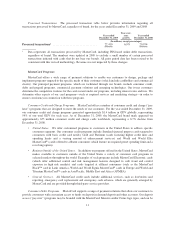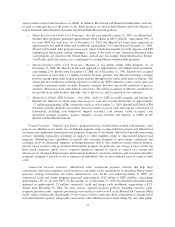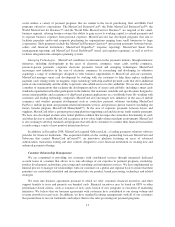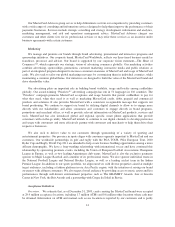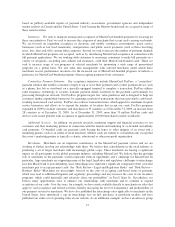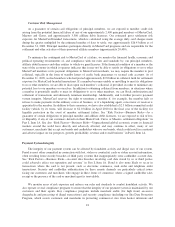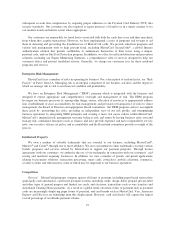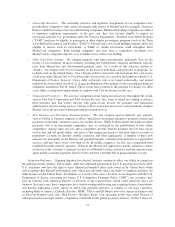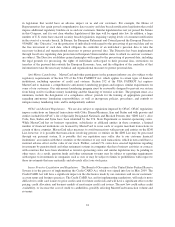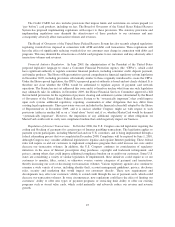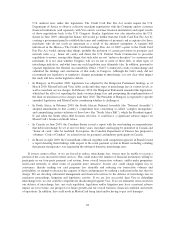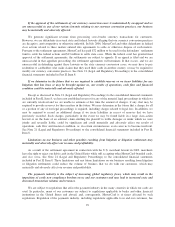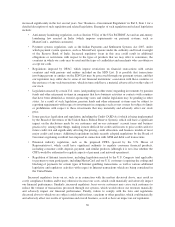MasterCard 2009 Annual Report Download - page 30
Download and view the complete annual report
Please find page 30 of the 2009 MasterCard annual report below. You can navigate through the pages in the report by either clicking on the pages listed below, or by using the keyword search tool below to find specific information within the annual report.Payment Card, Processing and Alternative Competitors.
•General Purpose Payment Card Industry. Within the general purpose payment card industry, we face
substantial and increasingly intense competition worldwide from systems such as Visa (including Plus,
Electron and Interlink), American Express and Discover, among others. Within the global general purpose
card industry, Visa has significantly greater volume than we do. Outside of the United States, some of our
competitors such as JCB in Japan and China Union Pay®have leading positions in their domestic markets.
Regulation can also play a role in determining competitive market advantages for competitors. For
example, China Union Pay is the sole domestic processor designated by the Chinese government and
operates the sole national cross-bank bankcard information switch network in China due to local
regulation. Some governments, such as South Africa and India, are promoting their domestic schemes
(Bankserv and India Pay, respectively) and other countries are proposing similar legislation. See “Risk
Factors—Legal and Regulatory Risks—Government actions could curtail our ability to compete
effectively against providers of domestic payments services in certain countries, which could adversely
affect our ability to maintain or increase our revenues” in Part I, Item 1A.
•Particular Segments. We face competition with respect to particular segments of the payment card
industry, including:
•Debit. In the debit card sector, we also encounter substantial and increasingly intense competition
from ATM and point-of-sale debit networks in various countries, such as Interlink™, Plus and Visa
Electron (owned by Visa Inc.), Star®(owned by First Data Corporation), NYCE®(owned by FIS),
and Pulse™(owned by Discover), in the United States, Interac in Canada and Bankserv in South
Africa. In addition, in many countries outside the United States, local debit brands serve as the main
brands while our brands are used mostly to enable cross-border transactions, which typically
represent a small portion of overall transaction volume.
•PIN-Based Debit Transactions. In the United States, some of our competitors process a greater
number of online, PIN-based debit transactions at the point of sale than we do. In addition, our
business and revenues could be impacted adversely by the tendency among U.S. merchants to
migrate from offline, signature-based debit transactions to online, PIN-based debit transactions
because we generally earn less revenue from the latter types of transactions. In addition, online,
PIN-based transactions are more likely to be processed by other domestic ATM/debit point-of-sale
networks rather than by us. See “Risk Factors—Business Risks—If we are unable to grow our debit
business, particularly in the United States, we may fail to maintain and increase our revenue
growth” in Part I, Item 1A.
•Private-Label. Private-label cards, which can generally be used to make purchases solely at the
sponsoring retail store, gasoline retailer or another merchant, also serve as another form of
competition.
•End-to-End Payment Networks. Our competitors include operators of proprietary end-to-end payment
networks that have direct acquiring relationships with merchants and direct issuing relationships with
cardholders, such as American Express and Discover. These competitors have certain advantages that
we do not enjoy. Among other things, these competitors do not require formal interchange fees to
balance payment system costs among issuers and acquirers, because they typically have direct
relationships with both merchants and cardholders. Interchange fees, which are a characteristic of four-
party payments systems such as ours, are subject to increased regulatory and legislative scrutiny
worldwide. See “Risk Factors—Legal and Regulatory Risks—Interchange fees are subject to
increasingly intense legal, regulatory and legislative scrutiny worldwide, which may have a material
adverse impact on our revenue, our prospects for future growth and our overall business, financial
condition and results of operations” in Part I, Item 1A. To date, operators of end-to-end payment
networks have generally avoided the same regulatory and legislative scrutiny and litigation challenges
we face because they do not utilize formal interchange fees. Accordingly, these operators may enjoy a
competitive advantage over four-party payments systems.
20



